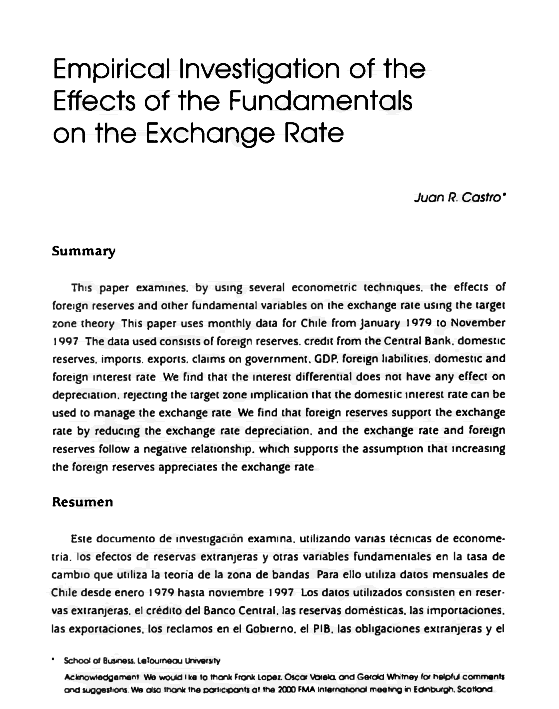Empirical Investigation of the Effects of the Fundamentals on the Exchange Rate
DOI:
https://doi.org/10.35319/lajed.20054269Keywords:
Econometrics, Exchange Rate, Central BankAbstract
This paper examines, by using several econometric techniques, the effects of foreign reserves and other fundamental variables on the exchange rate using the target zone theory. This paper uses monthly data for Chile from January 1979 to November 1997. The data used consists of foreign reserves, credit from the Central Bank, domestic reserves, imports, exports, claims on government, GDP, foreign liabilities, domestic and foreign interest rate. We find that the interest differential does not have any effect on depreciation, rejecting the target zone implication that the domestic interest rate can be used to manage the exchange rate. We find that foreign reserves support the exchange rate by reducing the exchange rate depreciation, and the exchange rate and foreign reserves follow a negative relationship, which supports the assumption that increasing the foreign reserves appreciates the exchange rate.
Downloads
References
Bosworth, Barry, Dornbush, Rudiger, and Laban, Raul, 1994, The Chilean Economy, Policy Lessons and Challenges, Brooking Institution, Washington, D.C.
Delgado, Francisco and Dumas Bernard, 1993, Monetary contracting between Central Banks and the design of sustainable exchange rates zones, Journal of International Economics, 34, 201-224.
Flood, Robert, and Andrew Rose, 1991, An empirical exploration of Exchange rate target zones, Carnagie-Rochester Series on Public Policy, Fall, 35, 7-66
Edwards, Sebastian and Jeffrey Frankel, 2002, Preventing Currency Crises in Emerging Markets, University of Chicago press.
Kaminsky, G. and C. Reinhart, 1998, Financial Crises in Asia and Latin America: Then and Now, American Economic Review, 88, 44-448.
Krugman, Paul, 1991, Target zones and Exchange rate dynamics, Quarterly Journal of Economics, 669-682.
Krugman, Paul and Miller Marcus, 1991, Speculative Attacks on Target Zones, Oxford: Oxford University Press.
Lewis, Karen, 1995, Occasional Interventions to Target Rates, American Economic Review, 691-715.
Lindberg, Hans and Soderlind, Paul, 1994, Testing the basic target zone models on Swedish data: 1982-1990, European Economic Review, 38, 1441-1469.
Lindberg, Hans, Soderlind, Paul, and Lars E. Svensson, 1993, Devaluation expectations: The Swedish krona 1985-92, Economic Journal, 103, 1170-1179.
Lopez, F. 1984. “The Effects of Various Credit Control in the Level of InternactionalReserves". Kredit and Kapital. January, vol 3. 404-416
Rangvid Jesper and Sorensen Carsten, 1998, Determinants of the Implied Fundamentals from a Target Zone, Working Paper, Department of Finance, Copenhagen Business School, Denmark.
Svensson, Lars E, 1991, Target zones and interest rate variability, Journal of International Economics, 31, 27-54.
---------- 1994, How long do Unilateral target zones last? Journal of International Economics, 36, 467-481.
Werner, Alejandro M, 1995, Exchange rate target zones, realignments and interest rate differentials Theory and evidence, Journal of International Economics, 39, 353-368.






